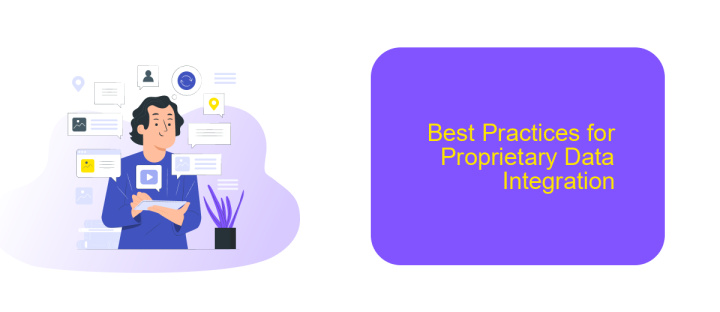Proprietary Data Integration
In today's data-driven world, proprietary data integration has become a critical process for businesses aiming to leverage their unique datasets effectively. By seamlessly combining various data sources, companies can gain deeper insights, enhance decision-making, and maintain a competitive edge. This article explores the importance, challenges, and best practices of integrating proprietary data to maximize its value and drive innovation.
Introduction
In today's digital landscape, the ability to seamlessly integrate proprietary data is crucial for businesses aiming to maintain a competitive edge. Proprietary data integration involves combining unique, often confidential, data from various sources to create a unified view that can drive strategic decision-making and operational efficiency.
- Enhanced data accuracy and consistency
- Improved decision-making capabilities
- Streamlined business processes
- Increased operational efficiency
One effective tool for achieving seamless proprietary data integration is ApiX-Drive. This service allows businesses to automate data transfer between diverse systems without the need for extensive coding. By leveraging ApiX-Drive, companies can ensure that their proprietary data is accurately and efficiently integrated, thus enabling more informed decisions and optimized operations.
Benefits of Proprietary Data Integration

Proprietary data integration offers numerous benefits for businesses looking to streamline their operations and enhance data accuracy. By utilizing proprietary systems, companies can ensure seamless communication between different software applications, reducing the risk of data silos and discrepancies. This integration enables real-time data sharing, which is crucial for making informed decisions and maintaining a competitive edge in today's fast-paced market. Additionally, proprietary data integration often comes with robust security features, safeguarding sensitive information from unauthorized access and potential breaches.
One of the key advantages of proprietary data integration is the ability to customize solutions to meet specific business needs. Services like ApiX-Drive facilitate this process by providing user-friendly tools to set up and manage integrations without requiring extensive technical expertise. ApiX-Drive allows businesses to automate workflows, thereby saving time and reducing the likelihood of human error. This not only improves efficiency but also enhances overall productivity, allowing teams to focus on strategic initiatives rather than repetitive tasks. In summary, proprietary data integration empowers businesses with enhanced data accuracy, security, and operational efficiency.
Challenges of Proprietary Data Integration

Integrating proprietary data systems presents numerous challenges that can hinder seamless data flow and operational efficiency. These challenges often stem from the unique and closed nature of proprietary systems, which are designed to work within specific parameters and may not easily communicate with other systems.
- Compatibility Issues: Proprietary systems often use unique data formats and protocols, making it difficult to ensure compatibility with other systems.
- Data Security: Ensuring secure data transfer between proprietary systems and external platforms is a significant concern, requiring robust encryption and access controls.
- Scalability: As organizations grow, integrating additional proprietary systems can become increasingly complex and resource-intensive.
- Vendor Lock-in: Dependency on a single vendor for proprietary systems can limit flexibility and increase costs over time.
- Customization and Maintenance: Proprietary systems often require specialized knowledge for customization and ongoing maintenance, which can be both time-consuming and costly.
To address these challenges, tools like ApiX-Drive can be invaluable. ApiX-Drive offers a user-friendly platform that facilitates the integration of various systems, including proprietary ones, by providing pre-built connectors and automation capabilities. This can significantly reduce the time and effort required to achieve seamless data integration, enhancing overall operational efficiency.
Best Practices for Proprietary Data Integration

Integrating proprietary data effectively requires a strategic approach to ensure seamless data flow and maintain data integrity. One of the best practices is to thoroughly understand the data structures and formats of the systems involved. This helps in designing a robust integration framework that minimizes data loss and inconsistency.
Another crucial aspect is choosing the right tools and platforms that facilitate easy and secure data integration. ApiX-Drive, for example, offers a versatile solution for connecting different systems and automating data transfers. It supports a wide range of applications and ensures that data is synchronized in real-time.
- Understand data structures and formats
- Choose the right integration tools like ApiX-Drive
- Ensure data security and compliance
- Monitor and maintain integrations regularly
Regular monitoring and maintenance of the integrations are essential to handle any discrepancies or updates in the data sources. By following these best practices, businesses can achieve efficient and reliable proprietary data integration, leading to improved decision-making and operational efficiency.


Conclusion
In conclusion, proprietary data integration remains a critical aspect for businesses aiming to streamline their operations and enhance data accuracy. By leveraging advanced tools and platforms, organizations can overcome the challenges of integrating disparate data sources. One such tool, ApiX-Drive, offers a robust solution for automating data flows between various applications, thereby reducing manual effort and minimizing errors.
As companies continue to grow and adopt new technologies, the need for efficient data integration will only increase. Investing in reliable integration services like ApiX-Drive not only ensures seamless data transfer but also provides scalability for future needs. Ultimately, the right data integration strategy empowers businesses to make informed decisions, driving innovation and competitive advantage.
FAQ
What is proprietary data integration?
Why is proprietary data integration important for businesses?
What are some common challenges in proprietary data integration?
How can businesses automate proprietary data integration processes?
What best practices should be followed for successful proprietary data integration?
Routine tasks take a lot of time from employees? Do they burn out, do not have enough working day for the main duties and important things? Do you understand that the only way out of this situation in modern realities is automation? Try Apix-Drive for free and make sure that the online connector in 5 minutes of setting up integration will remove a significant part of the routine from your life and free up time for you and your employees.

